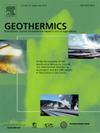Identifying aquifer thermal energy storage (ATES) key locations for hospitals in Lower Saxony, Germany
IF 3.5
2区 工程技术
Q3 ENERGY & FUELS
引用次数: 0
Abstract
In a decade of advancing energy transition, European countries, including Germany, face the challenge of managing seasonal imbalances in heating and cooling demands. Aquifer thermal energy storage (ATES), which uses groundwater as a storage medium in an open-loop geothermal system, offers a promising solution. Infrastructure requiring both heating and cooling, such as universities, data centers, shopping malls, office buildings, and hospitals, are particularly suited for ATES. Especially hospitals have high heating and cooling demands, making them promising candidates. This study evaluates the ATES suitability in the state of Lower Saxony, Germany, where geological conditions in many areas resemble those in the bordering Netherlands, the worldwide leader in the application of ATES. Hence, the study focuses on identifying ATES key locations in Lower Saxony by estimating the cooling capacities of 113 hospitals using visible compression chiller fans. Cooling capacities of up to 5.9 MW are detected, with a mean of 0.9 ± 1.2 MW. The results show that 57 % of the area with shallow porous aquifers in Lower Saxony is well or very well suited for ATES, with 60 hospitals located in these areas. ATES offers payback times of 2–10 years and CO2 savings of up to 74 % compared to conventional systems, highlighting its economic and environmental advantages. However, no system is currently operating in Lower Saxony and the lack of specific regulation for ATES hinders their development. Establishing supportive and novel policy frameworks could unlock the potential of this sustainable thermal energy storage technology.

确定含水层热能储存(ATES)在德国下萨克森州医院的关键位置
在推进能源转型的十年中,包括德国在内的欧洲国家面临着管理供暖和制冷需求季节性失衡的挑战。含水层热能储存(ATES)是一种很有前途的解决方案,它在开环地热系统中使用地下水作为储存介质。需要加热和冷却的基础设施,如大学、数据中心、购物中心、办公楼和医院,特别适合ATES。特别是医院有很高的供暖和制冷需求,使其成为有希望的候选者。本研究评估了德国下萨克森州的ATES适用性,该州许多地区的地质条件与毗邻的荷兰相似,荷兰是全球领先的ATES应用国。因此,研究的重点是通过估计113家医院使用可见压缩制冷机风扇的冷却能力来确定下萨克森州的ATES关键地点。检测到的冷却能力高达5.9兆瓦,平均为0.9±1.2兆瓦。结果表明,下萨克森州有57%的浅层多孔含水层地区很适合或非常适合ATES,这些地区有60家医院。与传统系统相比,ATES的投资回收期为2-10年,可节省高达74%的二氧化碳,凸显了其经济和环境优势。然而,下萨克森州目前还没有运行任何系统,而且缺乏对ATES的具体规定阻碍了它们的发展。建立支持性和新颖的政策框架可以释放这种可持续热能储存技术的潜力。
本文章由计算机程序翻译,如有差异,请以英文原文为准。
求助全文
约1分钟内获得全文
求助全文
来源期刊

Geothermics
工程技术-地球科学综合
CiteScore
7.70
自引率
15.40%
发文量
237
审稿时长
4.5 months
期刊介绍:
Geothermics is an international journal devoted to the research and development of geothermal energy. The International Board of Editors of Geothermics, which comprises specialists in the various aspects of geothermal resources, exploration and development, guarantees the balanced, comprehensive view of scientific and technological developments in this promising energy field.
It promulgates the state of the art and science of geothermal energy, its exploration and exploitation through a regular exchange of information from all parts of the world. The journal publishes articles dealing with the theory, exploration techniques and all aspects of the utilization of geothermal resources. Geothermics serves as the scientific house, or exchange medium, through which the growing community of geothermal specialists can provide and receive information.
 求助内容:
求助内容: 应助结果提醒方式:
应助结果提醒方式:


